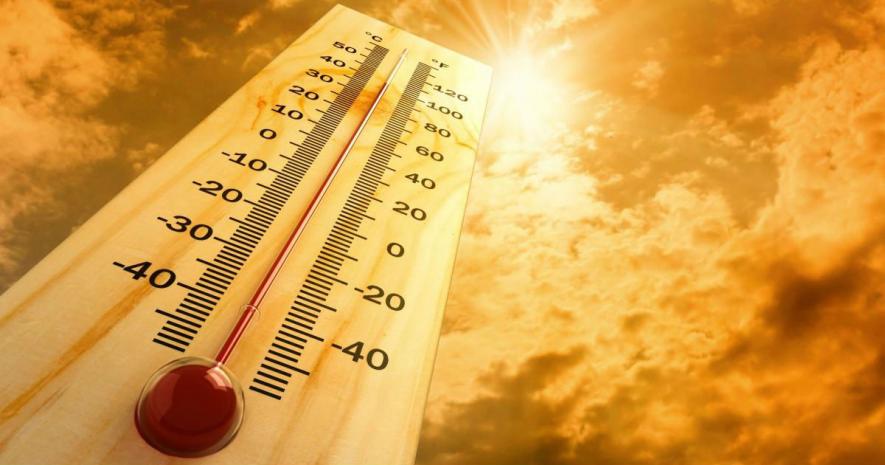Climate Change: Heat Stress Rising in India, Monsoons Hotter Than Pre-monsoons This Year

Patna/New Delhi: Nearly three weeks after the monsoon arrived in Bihar and across India, people, mainly the working class in cities are bearing the brunt of the hot climate during the ongoing monsoon season. It is something unusual as they expected relief from heat stress following the arrival of the Monsoon period.
Similarly, in rural areas, thousands of farmers are also facing a tough time saving their paddy saplings and paddy planted in the farmlands- so far due to rainfall deficit and now due to rising heat stress during the month of Ashad, traditionally known to be suitable for paddy cultivation.
According to the latest research study by the Delhi-based- Centre for Science and Environment (CSE), the Monsoon season is turning out to be hotter than the pre-monsoon period this year.
The report said, “monsoon is hotter than the pre-monsoon period on average, while winter and post-monsoon seasons are warming up faster: At an all-India level, the monsoon season (June, July, August, and September as per IMD classification) has been 0.3-0.4°C hotter than pre-monsoon (or summer) – what’s more, it is getting hotter with time.”
It pointed out that even though the monsoons have made headway across the country, there seems to be little respite from the searing heat because it’s aided by steep rises in humidity levels in many pockets. The heat waves lashing India this summer are symptomatic of the anomalous temperature trends that are expected to worsen with growing climate change impacts.
One of the key findings of the country-wide analysis is that the pre-monsoon summer heat levels in 2022 overtake 2016, as the second hottest pre-monsoon season on record for India. The seasonal average air temperature for 2022 pre-monsoon or summer (March, April, and May as per IMD classification), is 1.24°C warmer than the baseline trends that relate to 1971-2000 climatology (baselines are defined based on historical timelines and may vary for different metrics; the anomaly is generally computed from the 1951-80, 1971-2000, or 1981-2010 climatology baseline).”
This is warmer than the 1.20°C anomaly noted in the 2016 pre-monsoon but lower than the 1.45°C anomaly recorded in the 2010 pre-monsoon season.
Similarly, land surface temperature anomalies have been extreme this pre-monsoon season, with a 1.46°C departure from the baseline (1971-2000). It must be noted that pre-monsoon seasonal trends in both land and air temperature are identical to the annual trends, but with more pronounced highs and lows.
The decadal average temperatures for the pre-monsoon or summer period are now 0.49°C hotter than the long term normal (1951-80 baseline). This is a significant increase, but it pales in front of the increase noted among the decadal average temperatures for the other three seasons. The post-monsoon period (October, November and December as per IMD classification) is hotter by 0.73°C. Similarly, the winter (January and February as per IMD classification) has been warmer by 0.68°C, and the monsoon by 0.58°C.
As per the study, megacities including Delhi, Mumbai, Kolkata and Hyderabad are much hotter than the larger region around them due to heat island effects caused by surface absorption of heat and local waste heat generated by traffic, industries and air conditioning (among other urban activities).
“This is a very disturbing trend as policy preparedness to mitigate rising heat due to climate change is nearly absent in India. Without heat action plans, rising air temperature, radiating heat from land surfaces, concretisation, heat-trapping built structures, waste heat from industrial processes and air conditioners, and erosion of heat dousing forests, urban greens and water bodies will worsen public health risks. This requires urgent time-bound mitigation,” said Anumita Roychowdhury, executive director, research and advocacy, CSE.
She also pointed out that in this climate-constrained world, heat stress is expected to worsen. This in turn demands urgent action to adopt direct measures to mitigate heat across the region as well as the city to reduce public health risk and occupational exposure to heat, contain energy consumption due to increased demand for cooling, prevent damage to infrastructure, and ensure the overall wellbeing of the masses exposed to high and extreme heat.
“This rising heat stress demands urgent intervention to implement city and region-wise heat action plans to reduce the thermal loading and heat island effects that adversely affect public health, energy consumption and overall welfare,” Roychowdhury said.
Avikal Somvanshi, senior programme manager, Urban Lab, CSE, said that understanding the overall temperature anomaly, extreme heat conditions, and the mixed trends in heat patterns across different regions of India, has become necessary to assess the emergent risk. Currently, the attention is largely on the maximum daily heat levels and extreme conditions of heat waves. However, it is equally important to pay attention to the overall rising temperature and humidity trends in different regions to understand the gravity of the problem.
This year, the observed average daily maximum temperature for March and April for states and Union territories in India’s northwestern region (Chandigarh, Delhi, Haryana, Himachal Pradesh, Jammu & Kashmir, Ladakh, Punjab, Rajasthan, Uttar Pradesh and Uttarakhand – as per IMD classification), has been almost 4°C above the normal temperature (compared to its baseline of 1981-2010). This is almost twice as much as the anomaly observed at all India levels, and it holds true for even average daily minimum, daily mean and land surface temperatures. Even though, temperatures became relatively closer to normal during May.
In absolute terms, most of India outside the northwestern parts was hotter, even if the number of its extreme heat wave days, were lesser. The average daily maximum temperature for the northwestern states for March was 30.7°C, the all India average was 33.1°C (2.4°C hotter). The average daily minimum temperature shows an even larger (4.9°C) difference. The average daily maximum of northwestern states crossed the all-India average in April and May, but only by 1.0 -1.5°C. But, the daily minimum and average temperatures continued to be higher in other regions of India.
CSE analysis also highlighted that heat waves are the second deadliest natural force in India, after lightening, and have killed over 20,615 people from 2000-2020.
Get the latest reports & analysis with people's perspective on Protests, movements & deep analytical videos, discussions of the current affairs in your Telegram app. Subscribe to NewsClick's Telegram channel & get Real-Time updates on stories, as they get published on our website.
























